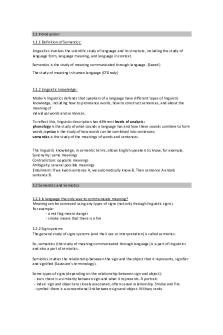Chapter 1 Summary PDF

| Title | Chapter 1 Summary |
|---|---|
| Course | Research Methods in Psychology |
| Institution | Athabasca University |
| Pages | 2 |
| File Size | 56.7 KB |
| File Type | |
| Total Downloads | 72 |
| Total Views | 170 |
Summary
chapter 1 summary...
Description
Chapter 1 Summery
1. Psychology is a science, essentially like any other science. 2. There are four ways of knowing about behavior: authority, logic, intuition, and science. 3. Authority plays a diminished role in science compared with other social institutions. 4. Logic plays an important role in science, but is secondary in importance to observation. 5. Common sense is limited in its usefulness to science because it changes from time to time and place to place, and cannot predict new knowledge. 6. Scientific knowledge often contradicts common sense, but ultimately it rests on a certain kind of common sense. 7. Science is a way of obtaining knowledge based on objective observations. 8. There is not one scientific method, but many scientific methods. 9. Science has the following characteristics: It is empirical, objective, self- correcting, progressive, tentative, parsimonious, and concerned with theory. 10. Science has five major working assumptions: the reality, rationality, and regularity of the world; the discoverability of how the world works; and the operation of causality. 11. Scientists assume that the world is real, but they do not assume that it is just the way it appears to be. 12. The assumption of rationality means that the world is believed to be understandable via logical thinking. 13. The assumption of regularity means that the world is believed to follow the same laws in all times and places. 14. The assumption of discoverability means that scientists believe that it is possible to find out how the world works. 15. The assumption of causality means that all events are believed to have causes. 16. The criteria of temporal precedence, co-variation of cause and effect, and elimination of alternative explanations are critical to establishing a cause- and-effect relationship between two events. 17. The goals of science include the discovery of regularities and the develop- ment of theories. 18. Discovering regularities includes describing behavior, discovering lawful relationships among aspects of behavior, and searching for causes. 19. Description of behavior is crucially important because it defines the subject matter for which laws are to be sought and theories developed. 20. Description can be thought of as creating the subject matter of science. 21. A law is a statement that certain events are regularly associated with one another. 22. The ultimate goal of science is the development of a theory to explain lawful relationships that exist in a particular field. 23. Broadly speaking, a theory is a set of statements about the relationships among variables. 24. More narrowly, a theory is a set of statements about relationships among variables that includes at least one concept that is not directly observed. 25. Theories and hypotheses must be capable of being tested empirically. 26. Theories guide research and, in turn, are modified by research in a continuous cycle. 27. Theories have three main functions in science: (1) organizing knowledge and explaining laws, (2) predicting new laws, and (3) guiding research. 28. A hypothesis is a statement that is assumed to be true for the purpose of testing its validity.
29. Operationism is the doctrine that scientific concepts must be tied to observable operations. 30. Although it is important to define theoretical concepts operationally, scientists agree that an operational definition does not completely define a concept. 31. Progress in science often involves a major shift in theories and assumptions, known as a paradigm shift, rather than a steady accumulation of knowledge....
Similar Free PDFs

Accounting chapter 1 summary
- 2 Pages

Chapter 1 summary
- 5 Pages

Sociology Chapter 1 Summary
- 2 Pages

Chapter 1 Summary
- 2 Pages

Chapter 1 Summary - nothing
- 2 Pages

Chapter 1-summary-abnormal
- 9 Pages

Summary Chapter 1
- 2 Pages

Chapter 1 Summary Notes
- 3 Pages

COMM 20 Chapter 1 Summary
- 2 Pages
Popular Institutions
- Tinajero National High School - Annex
- Politeknik Caltex Riau
- Yokohama City University
- SGT University
- University of Al-Qadisiyah
- Divine Word College of Vigan
- Techniek College Rotterdam
- Universidade de Santiago
- Universiti Teknologi MARA Cawangan Johor Kampus Pasir Gudang
- Poltekkes Kemenkes Yogyakarta
- Baguio City National High School
- Colegio san marcos
- preparatoria uno
- Centro de Bachillerato Tecnológico Industrial y de Servicios No. 107
- Dalian Maritime University
- Quang Trung Secondary School
- Colegio Tecnológico en Informática
- Corporación Regional de Educación Superior
- Grupo CEDVA
- Dar Al Uloom University
- Centro de Estudios Preuniversitarios de la Universidad Nacional de Ingeniería
- 上智大学
- Aakash International School, Nuna Majara
- San Felipe Neri Catholic School
- Kang Chiao International School - New Taipei City
- Misamis Occidental National High School
- Institución Educativa Escuela Normal Juan Ladrilleros
- Kolehiyo ng Pantukan
- Batanes State College
- Instituto Continental
- Sekolah Menengah Kejuruan Kesehatan Kaltara (Tarakan)
- Colegio de La Inmaculada Concepcion - Cebu






